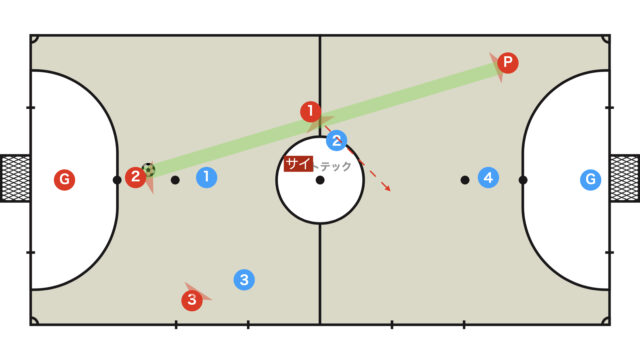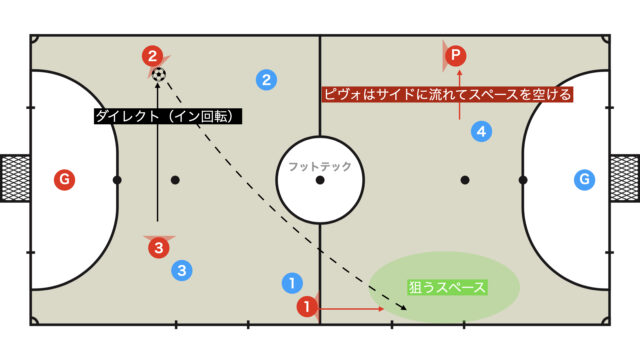For futsal beginners, isn’t L the second most famous tactic taught after Eight?
Now, here’s a question.
“Can you explain what L is?”
Very few can provide a perfect answer to this question; many seem to only understand the form without grasping the essence.
This article provides a thorough explanation of L—a highly renowned tactic that utilizes the pivo.
Tactical Intent and Essence of Pivo Play
Tactical Intent
- Penetrate the opponent’s territory and advance
- Create a positional advantage → shake off marking, induce own goals
After the pivo play, while the attacking side can proceed toward the goal with both the opponent’s defender and the ball in view, the defending side finds it difficult to retreat while keeping both their mark and the ball in sight. In other words, the field players other than the pivo on the attacking side can secure a positional advantage over the opponent’s defence.
This allows the attacking side to more easily shake off the opponent’s marking and induce own goals.
Essence of Attack and Defence

The essence of the pivo play tactic is presented separately for attack and defence.
When reverse-engineering from the creation of the finish triangle, it is ideal to complete the attack with three players—including the pivo—while the remaining player covers around the center circle to maintain balance.
It is best determined by the positioning during the pivo play (the distance from each player to the pivo, body orientation, distance relative to the opposing defender) and the players’ abilities (preferred foot, shooting power, speed, etc.).
While maintaining one’s own marking (man-to-man defence), retreat back to the ball line.
Since it is difficult to keep both the ball and your mark in view simultaneously, be sure to glance around as needed.
Pivo Play Positioning: L-Shape
The name of the tactic “L” originates from the fact that the positioning during the pivo play is L-shaped.
Although L is often presented as a sequence starting from a right-angle pivo play leading to the finish, in reality there are three patterns of pivo play.
- Right-angle pivo play
- Pivo play from Ala Corta (with fixo moving towards the ala)
- Pivo play after the ala performs a central dribble
All of these are common situations in 3-1 scenarios.
Since most players are right-footed, the subsequent explanation will assume the pivo initiates from the left side.
If you prefer to initiate from the right side, simply mirror the positioning accordingly.
Right-Angle Pivo Play

Red No.1 aims to execute the pivo play before the opposing defender can cut off the passing lane, so he strives to minimize the sequence from trapping to passing.
Therefore, a direct ground pass to the pivo is ideal.
Pivo Play from Ala Corta (with fixo moving towards the ala)
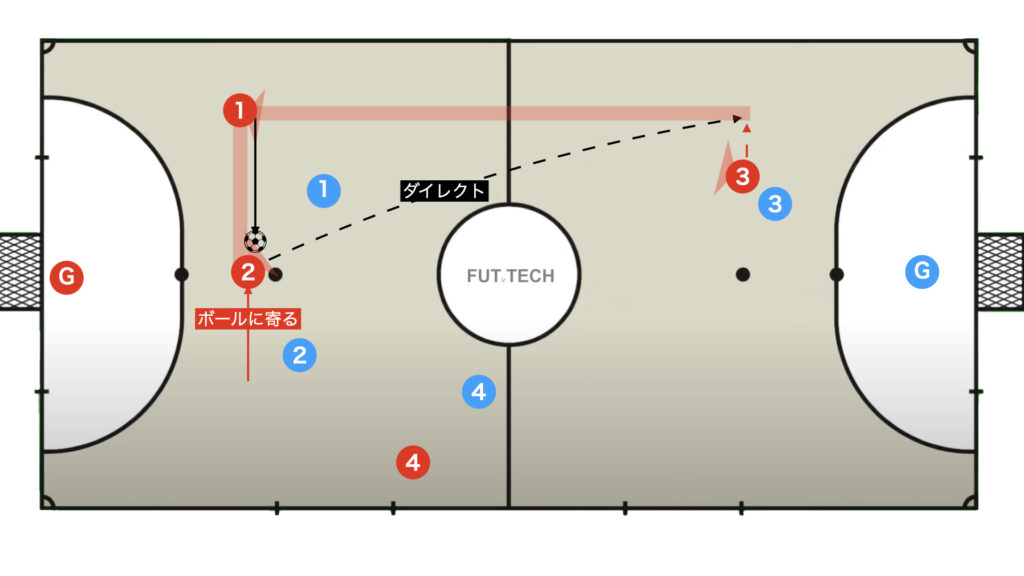
The method of delivering a short pass from the ala to the fixo—who then moves toward the ball for a direct pivo play—is highly effective as it can temporarily relieve pressure from the opposing defender.
However, this pivo play is difficult unless there is excellent coordination between the passer (ala) and the receiver (fixo).
When you hear “Ala Corta,” many might imagine the ala approaching the ball and trapping it as if caressing it with the sole of the foot.
However, in its Spanish etymology it is “a la corta” and is not limited to tactics involving only the ala.
Since “a la corta” simply refers to the movement of approaching the ball, it applies not only to the ala but also to the fixo moving toward the ball.
Pivo Play after the Ala Performs a Central Dribble
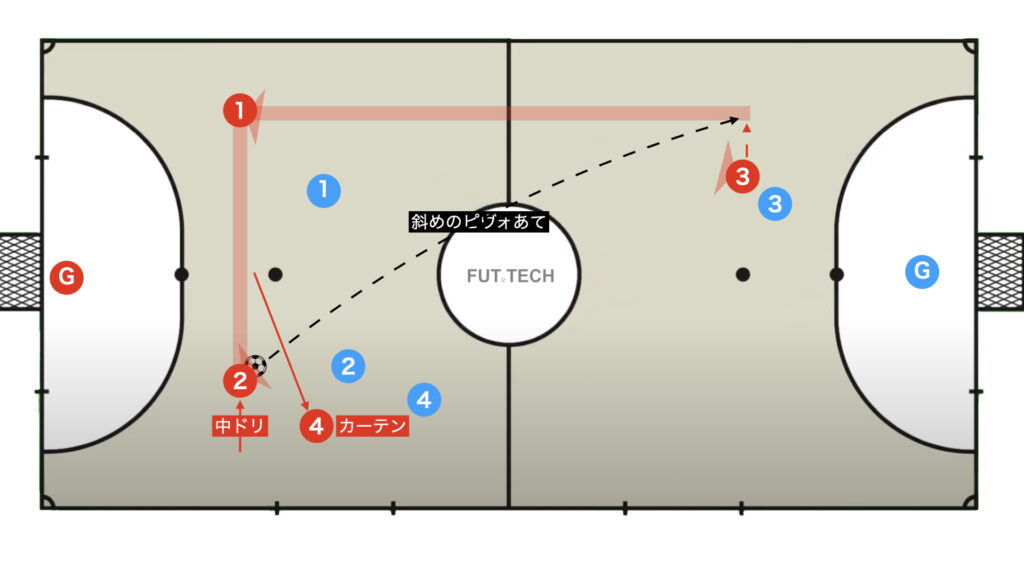
This is the pivo play commonly seen in the tactic known as Eight.
Actions Following the Pivo Play
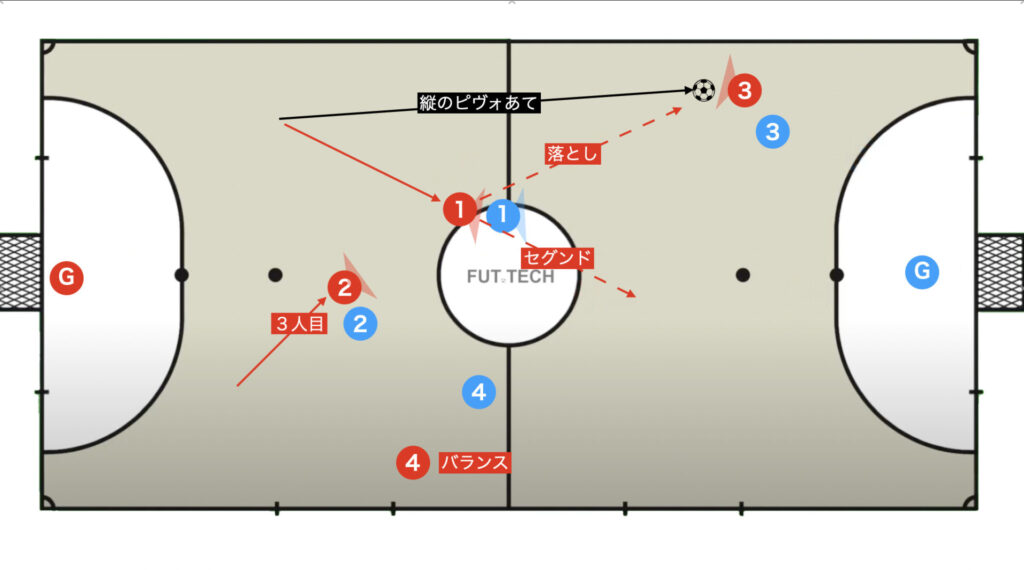
When executing the pivo play, especially if the abilities of each player do not vary significantly,
- The player closest to the pivo (Red No.1) makes a run for the segundo
- The player second closest to the pivo (Red No.2) gets involved as the third player
- The player third closest to the pivo (Red No.4) covers from the rear near the center circle
At this time, Red No.1 negotiates with the opposing defender between making a run for the segundo and going to receive the drop pass.
Blue No.1, due to a body orientation that prevents keeping both the ball and their mark (Red No.1) in view, finds it difficult to respond; this is one of the tactical aims of L.
Depending on the situation, Red No.4 may sometimes be closer than Red No.2, so teams can adjust the third player accordingly.
What is crucial is finishing before the opposing defence can organize; therefore, providing prompt support to the pivo after the play is key.
For this reason, it is advisable to decide which players get involved with the pivo based on their distance from it.
From here on, we will explain the breakdown starting from the vertical pivo play mentioned earlier, though the approach to finishing remains exactly the same for the other two types of pivo plays.
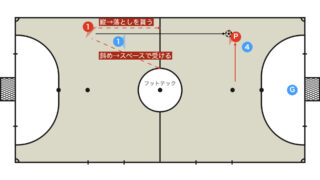
Pattern of Directly Receiving the Drop Pass Without Making a Run for the Segundo
If Red No.1, who executed the vertical pivo play, manages to completely shake off the opposing defender’s marking, there is an attacking pattern where he goes directly to receive the drop pass from the pivo.
It is important to choose the attack by reverse-engineering from the finish, without being bound by form.
Pattern Completed by a Duo (Ala–Pivo)
Vertical One-Two (Diagonal)
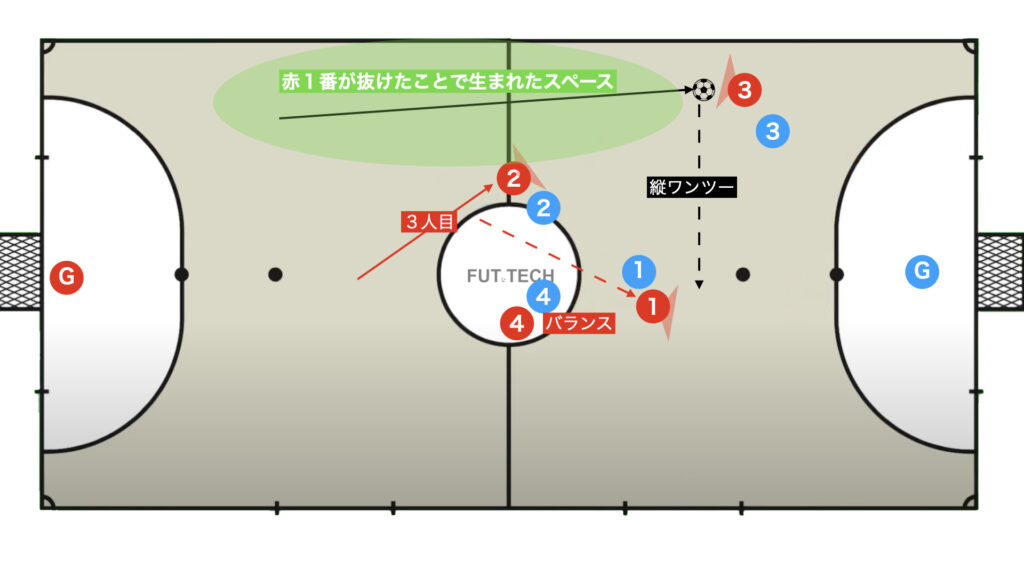
If Red No.1 manages to shake off the opposing defender, a through pass in front of the goal can create a one-on-one situation with the goalkeeper.
As shown in the diagram above, one tactical objective is for the third player to run into the space created by the segundo’s advance, thereby getting involved with the ball freely.
Fake a Run for the Segundo to Receive the Drop Pass
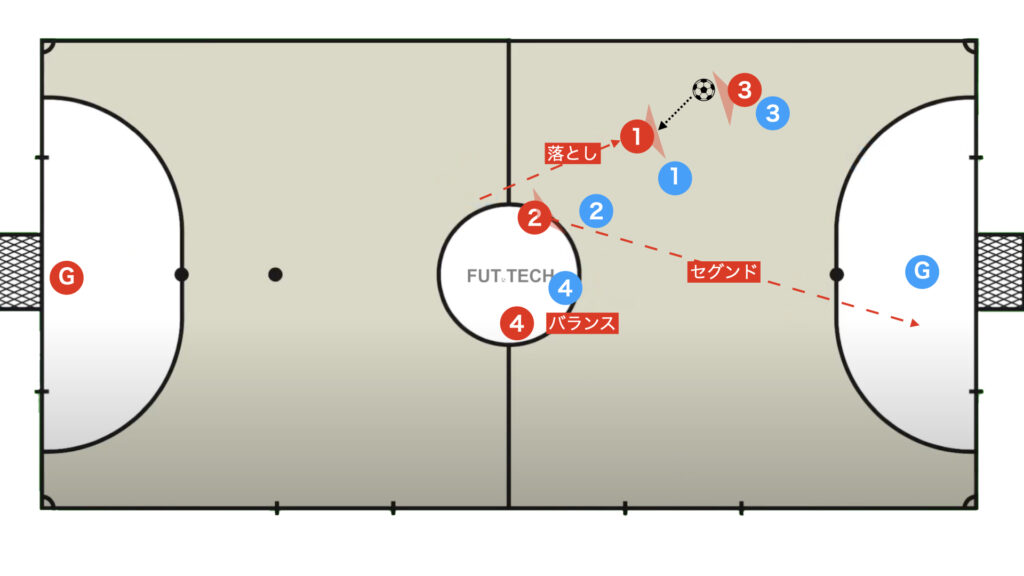
Faking a run for the segundo to receive the drop pass makes it easier to shake off the opposing defender.
At this time, it is preferable for Red No.2 (or Red No.4) to assume the segundo role.
Overlapping the Pivo without Receiving the Drop Pass
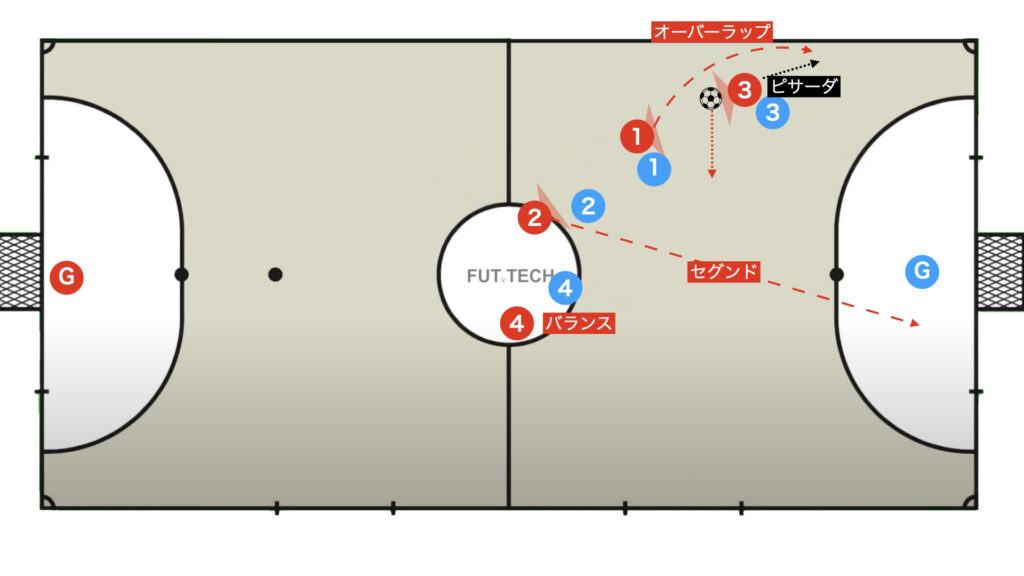
If Red No.1 cannot receive the drop pass from the pivo, he should simply overlap the pivo, using a combination of pisada and an inward rotation by the pivo to create play.
Pattern Completed by a Threesome
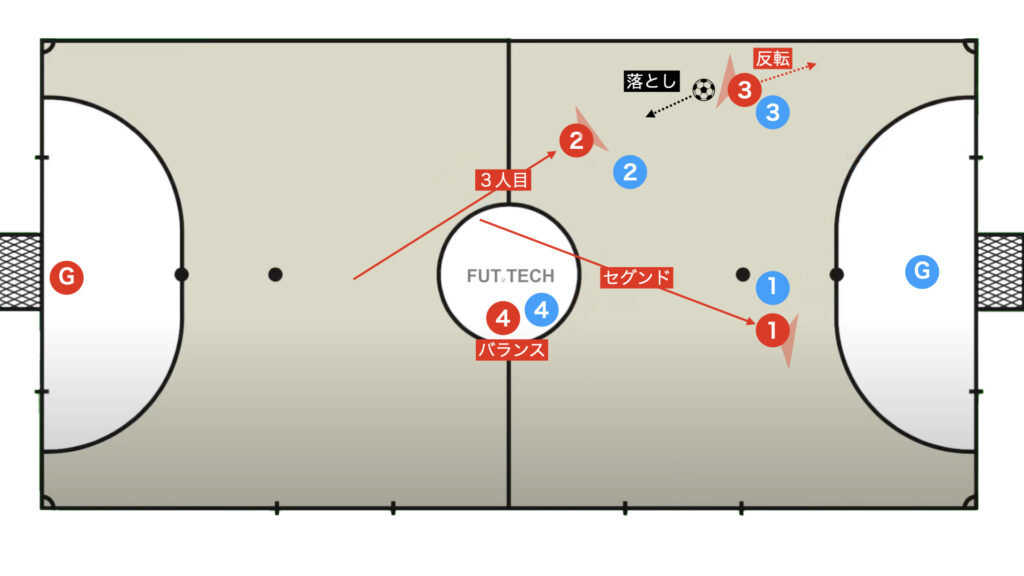
- If Red No.1 fails to shake off the opponent’s marking, he simply advances as the segundo.
- The third player (Red No.2) runs into the space created by Red No.1’s movement.
- Red No.4 maintains balance by covering around the center circle.
The Third Player Receives the Drop Pass from the Pivo
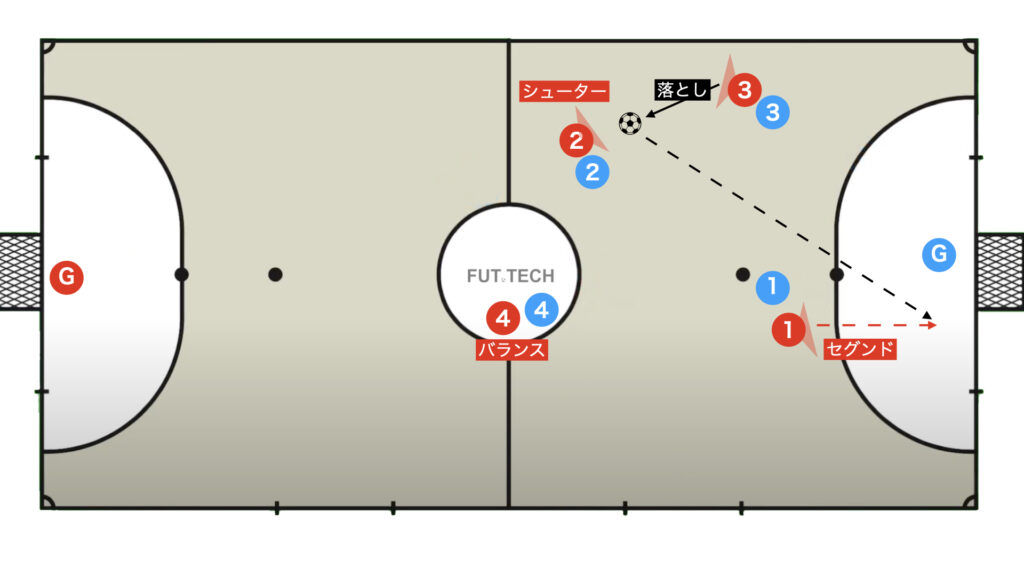
This simple finish is probably the most common form of L seen in play.
The shooter targets either the near player or the segundo.
The Third Player Overlaps the Pivo
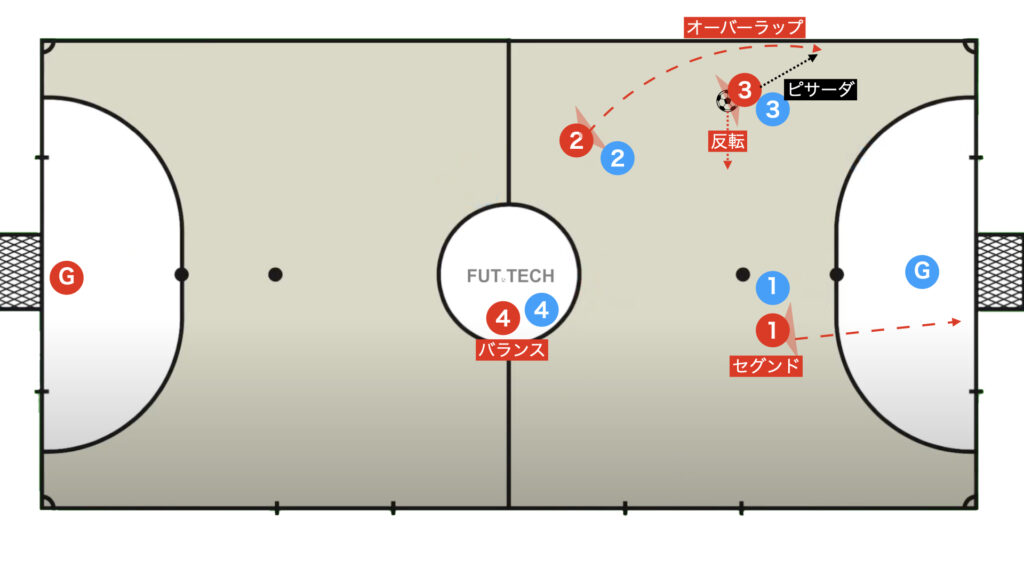
As before, if it appears unlikely to receive the drop pass, opt for overlapping.
Finish Following the Pivo’s Inversion

Once the segundo reaches the goal area, a rotation is triggered, and Red No.2 moves into a rebound position to form a finish triangle.
Supplement: Pivo Play Initiated by an Ala-Cut (Sai)
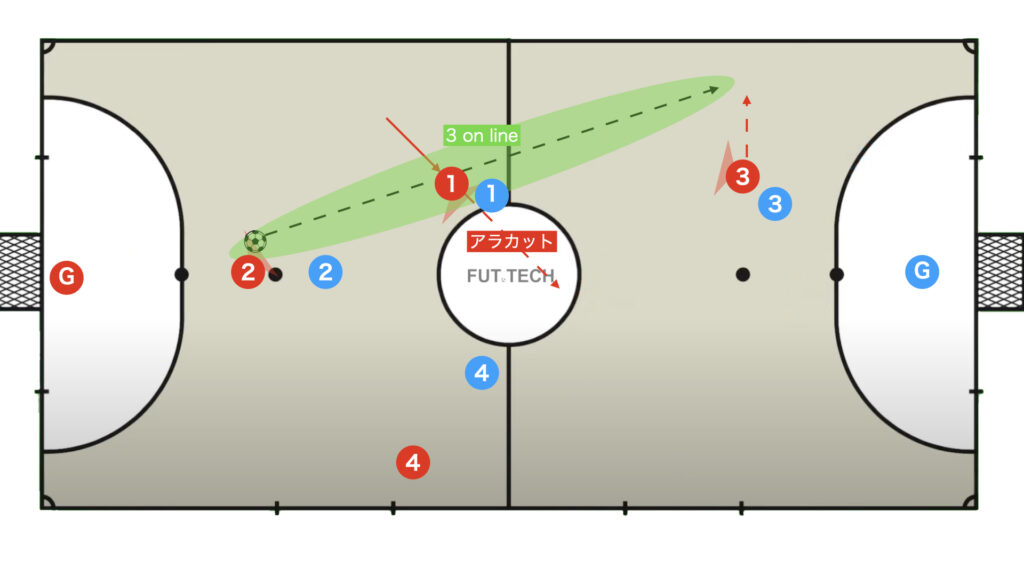
Although this deviates from the L-shape, even in pivo plays that begin with an ala-cut action—where the ala breaks away first to create a lane for the pivo—the exact same breakdown as explained for L applies.
In this case, the subsequent breakdown involves Red No.1 advancing as the segundo and Red No.2, who executed the pivo play, getting involved as the third player; since this overlaps with the breakdown in L, it will be omitted.

Summary
The L tactic discussed here is only one part of the tactics that utilize the pivo, but it is a highly effective component of a positional attack system (play model) that incorporates the pivo.
Not only applicable to 3-1, but also adaptable to tactics such as 2-1-1 and 2-2, this fundamental pivo play tactic is the basics of the basics—so be sure to master it.
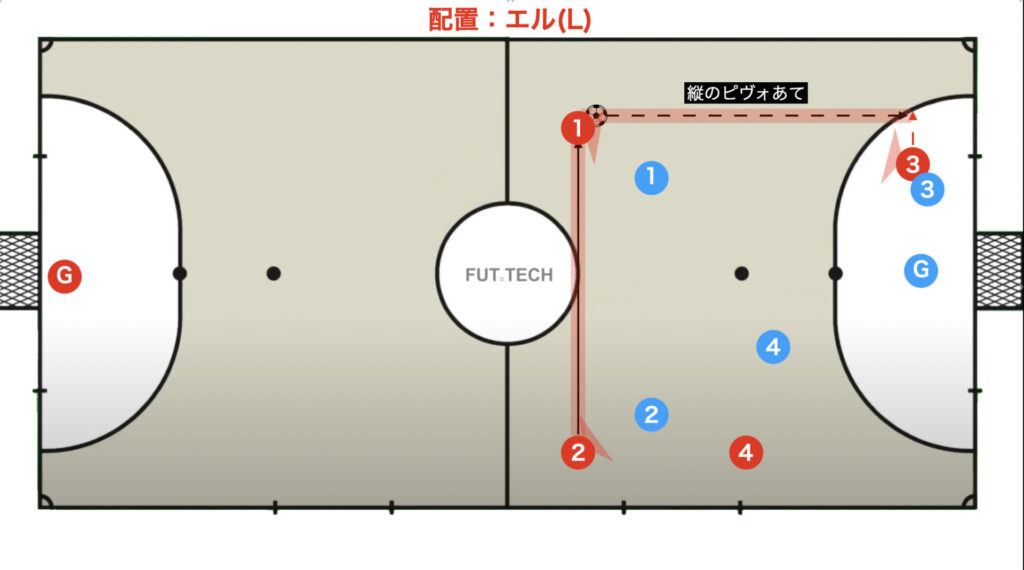
While this explanation focused on countering from one’s own half, the same principles can be applied to L tactics in the opponent’s half, as illustrated above.
Thank you very much for reading this article to the end.
If you found this article useful, please consider sharing it using the social media share buttons above.
We regularly share valuable insights on futsal tactics on Twitter, so if you haven’t followed us yet, we’d appreciate your support!
We are committed to raising the level of futsal in Japan by sharing high-quality information through discussions with individuals who have coaching experience in the F.League and overseas.
If you have any questions or notice any mistakes, feel free to leave a comment below.
We update our articles regularly, so if you’d like to keep reading, please bookmark our site or search for “FutTech”!

